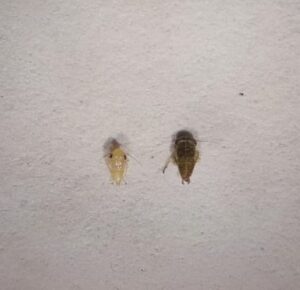Blunt-nosed leafhoppers (BNLH) are important pests of cranberries in NJ because they vector a phytoplasma that causes false blossom disease. BNLH has one generation a year. It overwinters as eggs, which begin to hatch in early May. The nymphs will go through five instars in about a month. The adults begin to appear by the end of June and are most abundant in mid-July. Numbers of this species start to diminish by the end of July. The adults have a characteristic blunt head and vary from light yellowish-gray to dark brown. Eggs are laid in June-July. Nymphs and adults get their food by sucking the plant juices of the cranberry vines with their piercing-sucking mouthparts. At this time of the year, we are observing early-instar nymphs, mostly 1st instars but also 2nd instars (Figure 1).

Figure 1. Blunt-nosed leafhoppers early-instar nymphs. Photo credit: Paolo Salazar-Mendoza.
Here are some guidelines to consider when managing BNLH in cranberries:
- The most important point in BNLH control is locating the sites of infestation. Monitoring for this insect is accomplished best with an insect sweep net. Nymphs should be monitored before bloom using sweep nets (this time of year). Nymphs before bloom are small (Figure 1); thus, ideally, you may need to freeze the samples (to kill them), and then count the number of nymphs under a microscope or using a magnifying lens.
- To monitor, perform sweep sets of 25 sweeps each. The recommended number of sweep sets is: 1 per 1–10 acres, at least 10 sweep sets per 10–20 acres, and 1 sweep set per 2 acres for more than 20 acres.
- A challenge for managing BNLH is the fact that they vector a phytoplasma that causes false blossom disease. For this reason, it is difficult to establish economic thresholds for this pest because we do not know the proportion of individuals that are infected in the population. Moreover, this proportion can vary depending on the variety. For instance, we have observed higher incidence of infection in the newer varieties even when populations of leafhoppers are low.
- Control measures should be considered based on the number of BNLH relative to previous years, history of insecticide application, and the variety. If BNLH populations are increasing compared to previous years and the beds have not been treated for BNLH for 2-3 years, growers should consider treatment.
- If treatment is necessary, we have a few options to manage BNLH. The best timing for insecticide treatment is before bloom to target the young nymphs. We recommend the use of organophosphates such as Diazinon (diazinon) and Orthene (acephate), carbamates like Sevin (carbaryl), and pyrethroids like Fanfare (bifenthrin) and Danitol (fenpropathrin). Although not proven scientifically, there are claims that Orthene and Sevin can reduce pollinator activity by repelling bees. The neonicotinoids Assail (acetamiprid) and Actara (thiamethoxam) also work well against nymphs, but we do not recommend their use before bloom due to potential negative effects on bees; neonicotinoids are systemic insecticides that can accumulate in the pollen and nectar. Closer (sulfoxaflor) is a new registered insecticide in cranberries with a similar mode of action as the neonicotinoids but that belongs to a different class of insecticides. We have tested Closer in small plot trials at the P.E. Marucci Center and shown that it is effective against BNLH nymphs; however, more data are needed to confirm its efficacy at larger scales in commercial farms.

